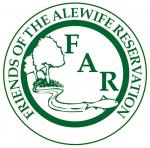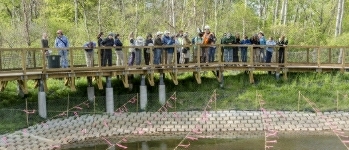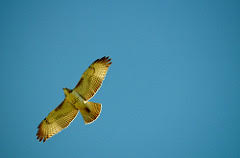Good news for followers of Buzz and Belle. As I posted a month ago, they had successfully fledged one chick, believed to be a male, who was called “B,” in a nest about a mile south of Buzz’s established territory in a private residential neighborhood of single-family homes.
There were a number of questions about what would happen after the nesting. Would Buzz return to his old territory and attempt to maintain it during the nesting? Would Buzz hunt in his old territory and courier the food to his new kid(s)? Would Belle return to Buzz’s old territory or spend more time where she had nested successfully? Would the fledgling(s), if any, stay in the new territory or would Buzz and Belle bring them to Buzz’s old stomping grounds? In essence, had Buzz and Belle changed their legal residence in Cambridge, or were they merely “house sitting” in an upscale residential neighborhood where they quickly tried to raise a brood? Would their kid(s) like the secluded quiet of the heavily vegetated back yards their natal neighborhood, or would they be attracted by the bright lights, pigeons and rodents of Fresh Pond Mall and Reservation? There were more traditional questions as well. Was the nest they were using one built more than a year ago and appropriated by Belle, or was it a new one built hurriedly by Belle??? (With Buzz????) A lot of questions. The answers, at least some of them, are unfolding slowly like the peeling of an artichoke with badly arthritic hands.
The kid fledged in the second week of July and Buzz began spending considerably more time in his old territory, “showing the flag” and hunting in more familiar environs. On more than one occasion he roosted at night in a favorite site he had shared with Ruby. Belle began increasing her time in Buzz’s old territory, especially around the RA, or radio antenna, just north of Concord Ave.
At about the same time the Watertown Peregrines, who successfully fledged four young this year – 2 males and 2 females – brought their brood to the bright lights and high-elevation perches of the Fresh Pond mall area, including Rindge Towers. Fairly quickly, however, they appeared to segregate their brood by gender. Dad and the two smaller boys seemed to disappear. They must have been roosting and hunting elsewhere. Perhaps Dad was taking the smaller, lighter, faster males to a location where they could practice hunting the smaller, faster, and more abundant prey that males tend to focus on. Where they could concentrate on grackles, blackbirds, and Robins.
Mom, however, hung out around the Rindge Towers, as did her two larger, heavier, slower, and more powerful daughters. These kids worked a much larger territory than their predecessors two years ago, which included the mall, Cambridgepark Drive, and a wider area to the northeast. The largest kid was so large she could be seen on the weather radar on the web! She required the largest band they regularly stock for Peregrines, bordering on that of a Redtail. She was unofficially called “Big Bertha” by several Peregrine people when she was banded, but the name cannot apply to her. Her half sisters(??) from two years earlier were also huge, somewhat larger than Mom. When we saw the size of the first juvenile female two years ago, she was so much larger than Mom she was named Big Bertha. When her sibling appeared a day or two later, confirmed by band records, she was even larger than Big Bertha, and became “Bigger Bertha.” This year’s two females were also large, but the largest was larger than even Bigger Bertha. Mom took at least an occasional pigeon for the girls. What was a bit telling that at least twice she took a pigeon and had difficulty lifting the prey to the top of Rindge Tours, 22+ stories high. I’ve seen her take a good-sized pigeon in tow that high many times before. Perhaps these were unusually large pigeons, but more likely it indicated the weight and strength Mom had lost while laying and incubating eggs and brooding young. Mothers of toddlers, like my granddaughter, know what I am talking about…..
Over the past several weeks, the young female Peregrines appear to have moved on, while Dad has reappeared without sons in tow. It appears that the kids have been weaned and Mom and Dad are back together on their wintering grounds. They are often seen from shortly after dawn to shortly after sunrise, but anything more is highly irregular. From some third-hand reports, the kids – at least two of them – might be hanging around their natal site more. Mom and Dad are lower key than early this spring, when Mom was begging Dad for food and trying to take and scarf down anything he brought back to the towers but did not offer directly to her. (Usually with great success.) The pressure is now off. Worthy of note is that this year I did not see, nor have I seen any reports, of territorial confrontation between the adult or juvenile Peregrines and Buzz, Belle, or B. (That does not mean something did not occur, but it was likely rare.) The juvenile Peregrines were occasionally seen strafing totally innocent Herring and Ring-billed Gulls flying innocently over the mall, apparently just for the thrill of the attack. Biggest Bertha twice stooped from so high, so fast, that she almost had gulls eating asphalt. It should also be noted that Buzz has rarely perched on 185 Alewife Brook Parkway or the CVS sign, which might appear to be a challenge to the falcons. On at least two occasions he was seen flying past Rindge Towers and as far as the Rte 2/16 rotary near Arlington, even perching on the lamps in that rotary, without evoking any falcon response. (Pointedly, no falcons were in sight anywhere when he ventured to these northern fringes of his previous territory.)
Two Peregrine incidents of special note. Four weeks ago Mark Resendes and I spotted an American Kestrel dive-bombing a Peregrine Falcon on Rindge 2. Harassing it multiple times, trying to drive it off the roof on the west side of the building. Courageous, but perhaps not too bright. Maybe just a foolish juvenile. The kestrel retreated to an antenna perch above the Peregrine, but on the other side of the elevator shafts, so its presence was not obvious. The Peregrine, an adult female, did not respond aggressively then. However, shortly thereafter a large female juvenile Peregrine came sailing in from the west, across Rte 16. As the juvenile cleared Rindge 1, the adult female took off and started dive-bombing the juvenile. Attacking her own kid! It drove the youngster back across Rte 16 air space, both birds screaming, where they were seen by Nancy Given. The adult female dominated, doing the hummingbird-courtship-like flights (deep-U-shaped swings) to harass the juvenile, who retreated west towards Belmont. This raised a lot of questions that weren’t answered when my megazoom photos confirmed that this female WAS NOT the adult female we had been seeing for a month or so. Mom Peregrine was just beginning to molt after her kids had become at least partially self-sufficient. This adult female was in virtually all new, fresh, adult plumage, with a whole new set of rectrices with bright white terminal bands. So who was this mystery female? Where did she come from? Was she an au pair from Watertown? A local female who had failed in a nesting attempt and thus molted much sooner than adult females who were going through the travails of child rearing? (Two years ago we had seen two adult females and an adult male with the three juveniles when they were first brought to Rindge Towers. The second female disappeared very shortly thereafter.) Might that explain why the adult female did not get its territorial dander up against that audacious female American Kestrel who had harassed it?
Over the past month of so, Belle has frequently been seen perching on the RA, especially in the early morning, and Buzz perching on 545 Fresh Pond Reservoir Place. For his first month after fledging B had resided primarily within several hundreds yards of the nest, being fed by his parents until roughly several weeks ago. From high-tree perches in his natal area he could likely see Mom and even Dad perched high on the Radio Antenna (RA). He was likely fed enough to be sustained in his natal area, but as his hunger increased, he might have flown tree hopping north to beg for more. Whatever, he ended up perching, begging and being rewarded in trees south of Concord Avenue, in an area Belle appeared to frequent increasingly over the past year, as far west as Fresh Pond Parkway. Buzz has been perching occasionally in this area near the parkway, and on the Sozio signs. Two weeks ago B for the first time was seen perching on the RA. I think it was ten days ago when I was parked at the Danehy lot off Bay State Rd when I saw a juvenile Red-tailed Hawk starting to soar up over the tree by the RA, and then saw two adults following. B soared quite high with Buzz and Belle soaring a little lower and behind him, drifting northeast out of sight. B now perches on the RA with some regularity, likely because that is where Mom often is.
This past week B was seen in Fresh Pond Mall, the first time to my knowledge that he has been sighted there! He had been quiet, but as I approached, he started begging loudly, which is when I discovered an adult (I think Buzz) perched on a lamp behind Cambridge Wine & Liquors next to Whole Foods. The adult flushed east and the kid followed, but he actually landed in the copse behind Dunkin Donuts outbound. That began a fascinating morning. (Mom and Dad Peregrine had been the first raptors of the day at sunrise, perched together on R1.) Much of this week. I’ve seen B hunting in the wooded strip along the southern reaches of Danehy. Yesterday he was seen soaring over Fresh Pond Mall by Mark Resendes, and this morning he sailed into Fresh Pond Reservation.
Since his fledging, B has been easy to find because of his almost constant begging calls. This has been true as he moved into the Fresh Pond Mall vicinity. He will sit near Buzz and Belle, begging and begging. He flies to specifically where they are and begs, landing on the RA beneath Mom and calling. Calling. We’ve seen him going after live prey including squirrels, Mourning Doves, and more, multiple times without any visible success. However, begging yields a small bird from Dad, a rabbit (that he apparently dropped from the pole), and several days ago, a young rat from Dad. Despite getting a rat in response to his begging, Buzz sat with the rat on a utility pole, while the kid sat elsewhere. When the kid finally came in to get the rat, Dad flew off a short distance, but the kid did not start eating the rat. It was still in its original wrapper! Buzz had apparently not opened up the rodent for eating. The kid took off without eating it. (Susan Moses said the rat was gone later, but I would bet that it was not the kid who took it.)
Several days ago, Buzz perched on the Raytheon satellite dish, something he has done very rarely for months. Today Belle was perched on the Raytheon dish, something I have not seen for roughly half a year. This morning the kid was seen multiple times, but I did not hear him begging once! (A first!) Buzz, Belle, and B are modifying their habits. For most of August they had been in the RA/Concord Rotary area, but they, especially Buzz, are now being seen around the Fresh Pond Mall, though rarely on 185. When will B finally be weaned? When, if ever, will he become self-sufficient? When will he leave Dad’s territory? Many juvenile Redtails leave Mom and Dad within two months of fledging. On some occasions kids hang around with their parents, or near their natal territory, for the fall and much of the winter, until Mom and Dad start getting ready for the next nesting season. The Mt. Auburn pair several years ago had their juveniles apparently hang around well into their second year. Will B live in Belle’s basement? Will he become more adept at taking live prey on his own? How does being an only child affect his development? (Kids often play house, hunt, and “fight” together, stimulating each other to learn more.) If you go to a mountainous site like Wachusett Mountain in August and September you will find small cadres of juveniles, not necessarily siblings, soaring and stooping together, like at a college mixer.
Thus, keep your eye (and ears) open around Fresh Pond Mall. Buzz and Belle are both still molting, primarily on their heads, about the last to go. They’ve essentially new flight feathers, and contour feathers, but they both need to visit the feather (hair) stylist. Buzz’s head looks lighter and mangier than usual, but he still has a dark throat and his wrong-legged aluminum band. Belle has a white throat, and is somewhat bigger than her mate. Both have bright red tails and their dorsal plumage is a brighter, more rufous brown than it is on juveniles, who look a lighter, flatter, more grayish brown. When seen soaring, even if you can’t see the tail, B has a two-toned upper wing, with the arm dark and the hand much lighter, often visible from below as well. The adults are more evenly colored above. Neither Buzz nor Belle has a heavy bell band, and they both have some rusty buffiness to their upper breast in fresh plumage. B has a moderately heavy, vertical belly band and is a flatter white below. He also has yellow eyes, and his tail is banded with thick and thin brown bands. Though his tail is banded, not red, those bands and the tips of his flight feathers look pretty rufous, as several of my photos show.
A fair number of new photos of Buzz, Belle and B have been posted at my flickr site, along with some comments on what is shown. Go to www.flickr.com/photos/30136859@N06/albums/72157627784588301 to see the new photos.
Hawk migration is getting seriously underway, so several Cooper’s Hawks have been seen around Fresh Pond in addition to the kestrel, the “stranger” Peregrine, and today an Osprey. Second-year Redtails are likely still molting into their first adult plumage. As ragged juvies, they tend to quietly keep out of the way. As they molt into “puberty” they can act and be treated quite differently. Buzz and Belle have been posting up recently at old locations where they’ve been seen rarely since May. They also been focusing much more attention on the south Danehy area than they have before, in part perhaps because the pair that used to claim much of Danehy and the land eastward to Mass Ave and Rindge has not been seen in the old territory. Perhaps one died, or they just broke up and looked for new mates. Whatever, Buzz and Belle appear to be stretching their holdings east and south.
There is a lot to look for in Buzzland in September. I look forward to seeing your reports of sightings and behavior. Buzz is BACK! (And Belle…)
- Home
- Directions
- FAR Wildlife Blog
- Calendar
- News
- Donate Now
- Get Social!
- Storm Water Wetlands
- Plants and Restoration
- Photos
- Videos
- About & Projects
- Master Plan for Alewife
- Archive
- Newsletters
- Contact
 Presentation Spotlighting Alewife Reservation
Presentation Spotlighting Alewife Reservation
 Follow us on Twitter
Follow us on Twitter
 Like us on Facebook
Like us on Facebook
 Follow us on Instagram
Follow us on Instagram
Forward our web address to a friend!
- An Urban Gem - Alewife Reservation Nature Preserve
- Envisioning The Silver Maple Forest
- History and Policies of Cambridge, Belmont, and DEP
- Storm Water Wetlands
- Friends of Alewife Reservation brochure
(front, back) - Technical Analysis of Upper Alewife Basin
- Watershed: An Excursion in Four Parts
- The River Is A Restless Spirit: Life in the floodplain forest
-
Assessment of Silver Maple forest for DEP Adjudicatory hearings and
Patrick Fairbairn, author of the Assessment - Community Native Garden Flora
The
Alewife Reservation
is a unique natural resource for the communities of Belmont, Arlington and Cambridge
and home to hundreds of species, including hawks, coyotes beavers, snapping turtles, wild turkeys and muskrats,
the reservation is a unique natural resource for the community.
Historical information (Powerpoint)
Friends of Alewife Reservation works to protect and restore this wild area and the surrounding area for the water quality, native plants, animals and over 90 bird species with paths for walking, running and biking, recreation, and for classroom education and research. We regularly steward and preserve the Reservation area for wildlife and for the enjoyment of present and future generations.

(video)
By-Laws
About Friends of Alewife Reservation
Statement of Purpose
Citizen Forester newsletter archive
The Birds of the Cambridge Region of Massachusetts

by William Brewster 1906
Nuttal Ornithological Society
Biodiversity Study of Alewife Reservation Area: Species, Habitat, Ecosystems

Inventories by David Brown, wildlife assessor (2003, 2004.) Published by and available from FAR for $10. Write or call for your copy. (sample)
Updated Dave Brown Inventories (2008, 2010)
Inventories of Alewife Reservation Wetland Plants by Walter Kittredge, Botanist (2013)
Email: alewife@greencambridge.org
Join our mailing list
For technical problems with this website, email: webmaster@friendsofalewifereservation.org


